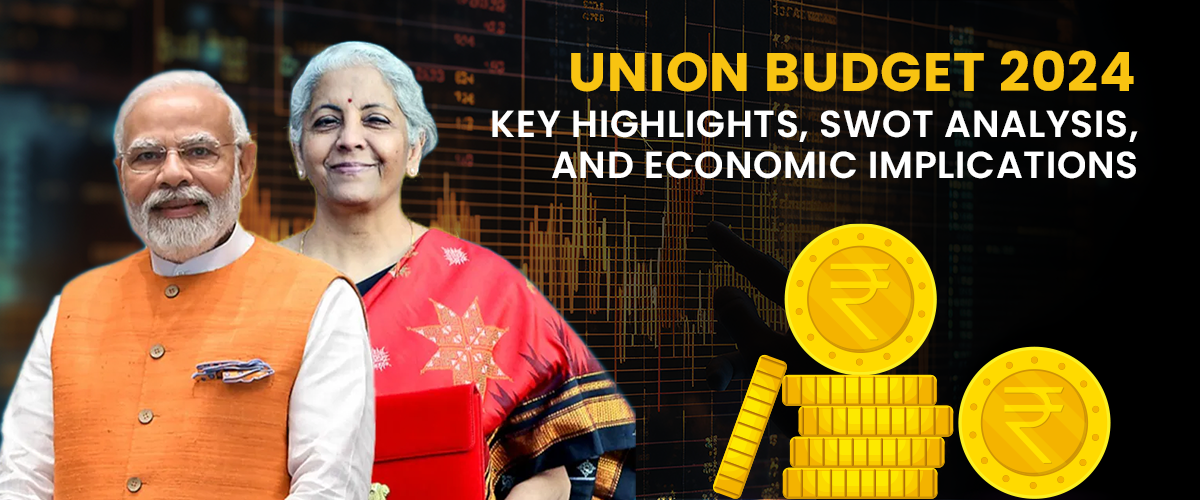
Union Budget 2024: Key Highlights, SWOT Analysis, and Economic Implications
The Union Budget for 2024, presented by Finance Minister Nirmala Sitharaman, outlines crucial financial decisions that will impact the nation's economy, tax system, and various sectors. This post will analyze key budget highlights and their implications.
Here are the key highlights of the budget presented by Finance Minister Nirmala Sitharaman,
Hike in Long Term Capital Gains Tax
- Long Term Capital Gains tax has been increased from 10% to 12.5% to boost revenue generation.
- This initiative aimed at equity investments addresses profit booking concerns amongst investors.
Tax Relief for Highest Tax Bracket
- Taxpayers with a taxable income of Rs 15 lakhs or above can benefit from a higher standard deduction, potentially saving Rs 7,500.
- These adjustments aim to ease the tax burden on higher-income individuals.
Support for MSMEs
- Mechanisms announced to ensure continuous credit flow to Micro, Small, and Medium Enterprises (MSMEs) facing financial stress.
- Acknowledgment of challenges faced by the sector and a commitment to supporting its growth.
Emphasis on Climate Finance Taxonomy
- Government planning to develop taxonomy for climate finance to boost funding for climate adaptation and mitigation.
- Aligning financial resources with green initiatives and climate commitments.
Boosting the Space Economy
- Introduction of a Rs 1,000 crore venture capital fund to accelerate the growth of the space sector.
- Aiming for a significant expansion over the next decade in the space industry.
Digitization of Urban Land Records
- Urban land records to be digitized with GIS mapping, aiding property tax collections.
- Enhancing property tax revenues for urban local bodies through improved record management.
Changes in Direct Taxes
- Proposed increase in standard deduction from Rs 50,000 to Rs 75,000, with adjustments in income tax slabs.
- Potential tax savings of around Rs 17,500 annually for taxpayers under the new regime.
Market Reaction and Political Implications
- Initial market fluctuations post-Budget presentation, with subsequent recovery.
- Budget designed to ensure political and macroeconomic stability, with special attention to key allies and states.
Pradhan Mantri Awas Yojana-Urban
- Significant investment of Rs 10 lakh crore for constructing 1 crore houses in urban areas.
- Central assistance of Rs 2.2 lakh crore to drive affordable housing initiatives.
Financial Sector Vision and Strategies
- Government set to release a Financial Sector Vision and Strategy Document for the economic sector's preparedness.
- A roadmap for regulators, financial institutions, and market participants for the forthcoming years.
Development Initiatives and Schemes
- Focused initiatives on Bihar's tourism development, tribal welfare schemes, and infrastructure projects.
- Commitment towards research on small modular nuclear reactors and advancement in thermal power plants.
Let’s have the SWOT analysis of the budget to find the key Strengths, Weaknesses, Opportunity and Threats
Strengths
- Prioritization of Key Sectors: The budget demonstrates a strong focus on crucial sectors such as agriculture, employment, human resource development, and social justice. This prioritization aligns with the government's commitment to inclusive growth and development.
- Revised Income Tax Slabs: The revised income tax slabs aim to reduce the tax burden on lower-income earners, potentially leading to increased disposable income and higher consumer spending.
- Allocations for Social Sectors: Significant allocations for health, education, and rural development reflect a commitment to human capital development and social welfare, addressing the immediate needs of the population.
- Strategic Investment in Infrastructure: The substantial capital expenditure and a focus on infrastructure development can act as a catalyst for long-term economic growth, fostering job creation and industrial advancement.
Weaknesses
- Fiscal Deficit Concerns: The estimated fiscal deficit of 4.9% of Gross Domestic Product (GDP) raises concerns about government borrowing, potentially impacting macroeconomic stability and inflation rates.
- Revenue Shortfall Risks: Dependence on revenue receipts and concerns about meeting revenue targets could pose challenges in funding critical schemes and projects.
- Limited Scope for Private Investments: The budget may need to do more to attract private investments and enhance public-private partnerships to drive sustainable economic growth.
- Inflationary Pressures: The increased capital expenditure and potential fiscal deficit can lead to inflationary pressures, impacting consumers and businesses.
Opportunities
- Stimulating Consumption and Investments: The revised income tax slabs and increased allocations for key sectors present an opportunity to stimulate consumption and incentivize investments.
- Infusing Innovation and R&D: The focus on innovation, research, and development presents opportunities for technological advancements and fostering a knowledge-based economy.
- Encouraging MSMEs and Startup Ecosystem: The budget could further strengthen support for Micro, Small, and Medium Enterprises (MSMEs) and startups, fostering entrepreneurship and job creation.
- Strengthening Social Infrastructure: Opportunities exist to enhance social infrastructure, including healthcare facilities, education systems, and rural development, to address long-standing social challenges.
Threats
- Global Economic Uncertainties: External factors such as geopolitical tensions and global economic uncertainties could impact India’s growth trajectory and trade relations.
- Rising Cost of Borrowing: A high fiscal deficit may lead to increased cost of borrowing, potentially crowding out private investments and raising interest rates.
- Implementation and Execution Challenges: The effective implementation of proposed schemes and projects within the allocated budget could pose logistical and administrative challenges.
- Geopolitical Risks: Any geopolitical events or disruptions that impact key sectors such as energy security and trade could pose threats to the budget's execution.
Conclusion:
The Union Budget 2024 presented a mixed bag of policies. While it addressed some pressing issues, it also raised concerns about fiscal sustainability and its ability to create broad-based economic growth. The extent to which the budget translates into tangible benefits for the common citizen remains to be seen. Only time will tell if it was a masterstroke of political strategy or a missed opportunity for transformative economic reforms.